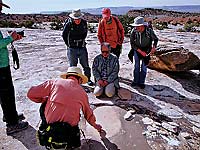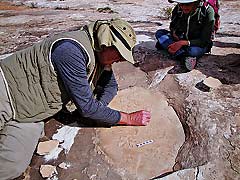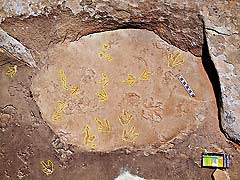 Last month we introduced you to the Moab Megatracksite, explaining how it consists of a truly extraordinary track-rich Jurassic surface extending over a huge area between the Colorado-Utah border in the east, and as far as Escalante Canyon in the west. Our Tracker’s group has found more than 40 different tracksites, including interpretative sites you can visit like the Bull Canyon overlook, in the La Sals and the Stomping Ground near the Copper Ridge site in the North Klondike area. The latter site has more than 2200 large theropod tracks, which took a team of six trackers two weeks to map out, back in 1988. But did they find all the tracks? Here we can report the answer is: “NO.”
Last month we introduced you to the Moab Megatracksite, explaining how it consists of a truly extraordinary track-rich Jurassic surface extending over a huge area between the Colorado-Utah border in the east, and as far as Escalante Canyon in the west. Our Tracker’s group has found more than 40 different tracksites, including interpretative sites you can visit like the Bull Canyon overlook, in the La Sals and the Stomping Ground near the Copper Ridge site in the North Klondike area. The latter site has more than 2200 large theropod tracks, which took a team of six trackers two weeks to map out, back in 1988. But did they find all the tracks? Here we can report the answer is: “NO.”
In December of 2018 one of us (Doug) visited the Stomping Ground site, stopping nearby, at a familiar boulder, used many times as rest stop. When preparing to leave, a casual glance revealed what appeared to be a familiar raven track in the sand. But no! Looking again these were tracks in the rock! Could they be some sort of Jurassic raven?
 We would later show that we had found a rare soft, sweet spot, in the dunes where about 20 small delicate tracks mostly only about 3 inches (8 cm) long, had been preserved for posterity. Geological clues tell us that while the waves of a ~160 million year old sea lapped on an extensive beach patrolled by large carnivores, leaving footprints, named Megalosauripus, up to 16 inches (40 cm) long (Happenings Feb 2020), just a few 100 meters inland raven-sized trackmakers were leaving footprints in the coastal dunes. Trackers have learned that most tracks in fossil sand dunes represent the desert ecology of small animal communities.
We would later show that we had found a rare soft, sweet spot, in the dunes where about 20 small delicate tracks mostly only about 3 inches (8 cm) long, had been preserved for posterity. Geological clues tell us that while the waves of a ~160 million year old sea lapped on an extensive beach patrolled by large carnivores, leaving footprints, named Megalosauripus, up to 16 inches (40 cm) long (Happenings Feb 2020), just a few 100 meters inland raven-sized trackmakers were leaving footprints in the coastal dunes. Trackers have learned that most tracks in fossil sand dunes represent the desert ecology of small animal communities.
This “new” discovery reminds us to look twice, and look closely. Not all dinosaur tracks are big. More than 30 years after the discovery of the Moab Megatracksite in all its immensity, the trackers are filling in valuable details. In March 2019, we were thrilled to bring a half dozen of our keen-eyed local and international tracker colleagues, including one from Japan, to see this new site. (Yes, Moab attracts professional international trackers, and we have not been idle since. Our group has already found new “megatracksite” locations in 2020)! 
So Moab Megatracksite studies are ongoing, with 40 + sites representing large, beach-roamer tracks, but only three with bird-sized tracks of dune dwellers. Both the small and large tracks represent theropods, which we now know to be ancestors of modern birds. Coincidentally for our story, it is part of tracker folklore that the first fossil footprints ever found in North America, were named by local people as tracks of Noah’s Raven.
Were small track makers rarer that the large ones? Perhaps not, but their spoor may be harder to find. Bird-like lightweights were less likely to leave tracks on most surfaces, and they liked different habitats. Thus, the tracker needs to be extra observant, and perhaps also a little lucky.
Visit Moab Giants at 112 UT-313, just 11 miles north of downtown Moab.
Starting February 14th, Moab Giants will be open 10am - 6pm daily.